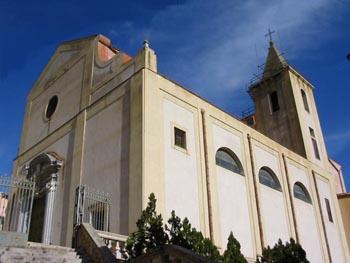The Church of SS. Salvatore, known as the Collegiata , located at the northern end of the town and in an elevated position, already existed in 1454. Seat of the confraternity of SS. Crocifisso is indicated as the first stationary church of the Lenten processions. Archbishop Venero, miraculously cured of the plague and buried here in 1628, had its architectural structure enlarged, entrusting priests with the custody of the statue of the venerated wooden crucifix. Since 1624, the year of the plague, every 3 May, the statue is carried in procession through the streets of the city from the church. According to popular tradition, at the end of the 16th century, the Crucifix was stolen from a Turkish ship sailing in the Mediterranean. Contended by the Christian crew of Palermo and Monreale, a decision was made to place the sacred object on an ox-drawn cart: a church to house the Crucifix would be built wherever it stopped, . The oxen stopped their journey in Monreale territory at the place where the Collegiate Churchstands today. In 1719, the church was enlarged and embellished with stuccoes, paintings and altars. Part of the original stucco decoration made in 1723 by Giacomo Serpotta remains on the sides of the larger one. It included a figure of the Almighty, statues of the four evangelists and ten heads of cherubs for the nave, completing Giacomo Guastella's architectural and decorative studies. After the neoclassical restoration in 1840, only two statues survived, which were transformed into St Peter and St Paul. History and devotion blend in the Carrubbella district, so called because of the presence of spontaneous carob vegetation, developed around the 15th century. Access was gained through Porta Carrubbella. Legend has it that Guglielmo II fell asleep under a carob tree and in his dream the Virgin Mary showed him the place where he would find the treasure for the construction of the Cathedral. The evergreen carob tree is commonly found throughout the Mediterranean. Because of the richness of this reddish, hard and heavy wood, which was used to build ships and furniture, the district was inhabited by master carpenters and craftsmen who used it to make decorative objects. The seeds of the plant, which are oval and very hard, were once used as weights for gold, silver and precious stones.
Credits: Arch. Paola La Scala
